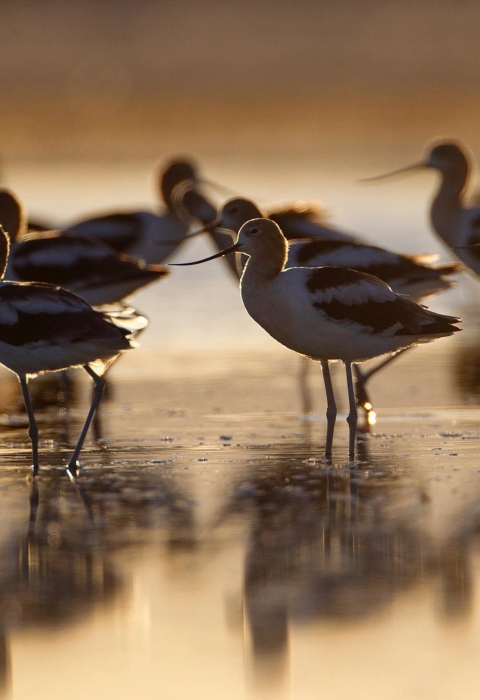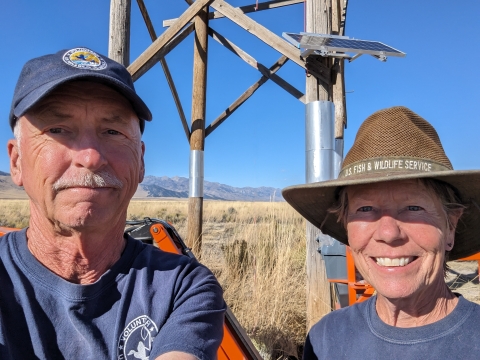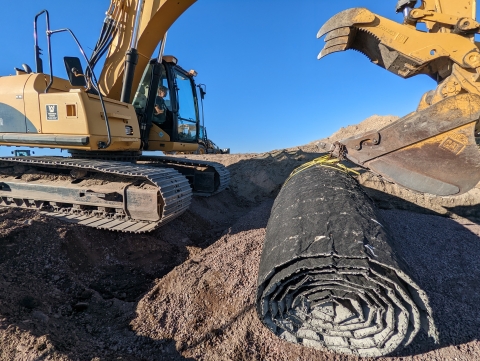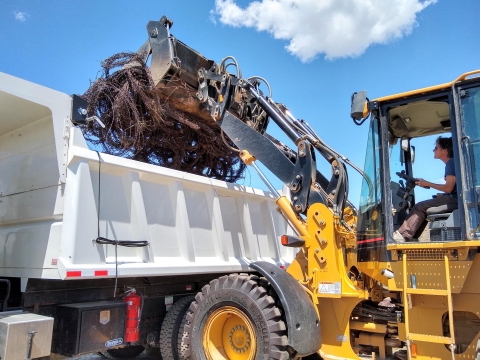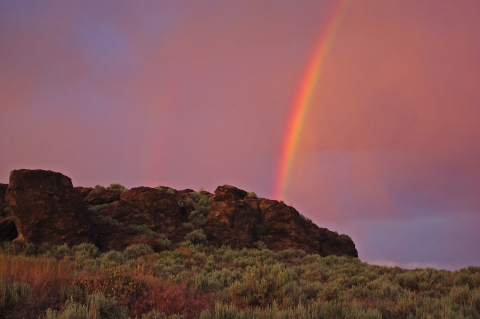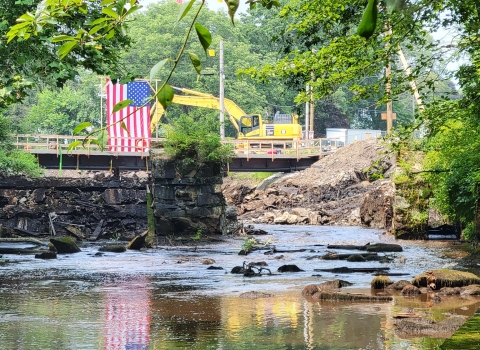By Jan Peterson, for the Pacific Region of the U.S. Fish and Wildlife Service
To say Mark Ackerman and Joyce Atkinson have wide-ranging interests and talents would be a vast understatement.
Before they met, they each had their own lanes. He owned an electronics company for about 20 years. She had a wide variety of occupations including education coordinator and manager of the Rachel Carson Component of the North Carolina National Estuarine Research Reserve, a federal-state partnership between the National Oceanic and Atmospheric Administration and the N.C. Division of Coastal Management.
When the two met more than 20 years ago, their lives took an entirely different trajectory.
“When I met Joyce, it just opened a whole world of possibilities,” Ackerman says. “Since we’ve known each other, we’ve worked as U.S. Merchant Marine captains, scuba diving instructors, Motorcycle Safety Foundation instructors, EMT/paramedics. Then when we retired from paramedicine, we decided we want to travel.”
Twelve years ago, the two moved into an RV full time and did just that. But they realized soon enough travel alone wasn’t all that satisfying. “Traveling around was great, but if you go to a place for a week, maybe two weeks and stay, you don’t really get to be involved with the community. You’re just doing tourist things,” Ackerman says.
They began volunteering as camp hosts at state and national parks. “It was great, but it didn’t really fill all the little places in our hearts that we wanted to,” Ackerman says.
Then the couple spotted a volunteer opportunity at the Arapahoe National Wildlife Refuge in Walden, CO. The refuge manager got the volunteers involved not just in guest relations, but projects that dealt with infrastructure and conservation. They were helping the U.S. Fish and Wildlife Service achieve its mission – ensuring that future Americans will benefit from the natural resources that define our nation – fish, wildlife, plants, and their habitat.
This is the meaningful work Ackerman and Atkinson were looking for – since then they’ve added Desert and Malheur National Wildlife Refuges to their volunteer portfolio. The National Wildlife Refuge System protects billions of acres of public lands and waters from the shores of New Jersey to the Mariana Trench. Some of our greatest national wild places and most iconic wildlife are protected because of the refuge system. In the last seven years, duo has logged more than 10,000 hours each, completing projects at 11 national wildlife refuges across the country.
Their contributions to the refuge system have been so great, Atkinson and Ackerman were selected Volunteers of the Year at the 2023 Wildlife Refuge Awards, held by the National Wildlife Refuge Association in Washington, D.C.
“The award ceremony was great – totally unexpected,” Ackerman says. “I won’t say unnecessary because we really enjoyed the appreciation, but that’s not why we do it.”
Ackerman says their diverse backgrounds are uniquely suited to solve problems. “Together, Joyce and I have started making that our schtick: We solve problems. We can see problems. We either know how to fix it or find a solution for it,” he says.
They’ve volunteered at Oregon’s Malheur National Wildlife Refuge for more than a decade. The work they’ve done to support the refuge is essential, supporting habitat and wildlife management goals. Established to protect native wildlife, the refuge is an important stop along the Pacific Flyway as a resting, breeding and nesting area for hundreds of thousands of birds. The refuge has been part of the local community for more than 100 years.
The two say they really enjoy volunteering at Malheur. “Malheur’s staff has a great working relationship with their volunteers,” Atkinson says. “Malheur (as well as all other refuges) has many projects that they need help with, which keeps us both challenged and engaged.”
Tara Wertz, who recently retired as deputy project leader at Malheur, says the two volunteers were instrumental in completing vital projects in the last couple of years. Projects include replacing an older security camera system with one that meets federal security guidelines, which required rewiring the entire system and integrating new hardware and software. “This alone would have cost tens of thousands of dollars to have a contractor install,” Wertz says.
Atkinson and Ackerman also renovated a boat ramp and installed a base mat to retain the surface of the ramp and installed four HVAC units that had been sitting around for a year because Wertz couldn’t find a vendor in Eastern Oregon willing to install them.
“We do a lot of electrical, electronic or security,” Ackerman says. “You name something that’s broken, we can probably tell you we can work on it.”
Ackerman says another big project was addressing poor cell phone coverage at Malheur, which is in a remote location, far from the nearest cell phone towers. “We installed cell phone boosters there in all the residences and the main offices so volunteers and staff could stay in touch,” he says.
But their expertise extends well beyond electronics. They literally move the earth to get things done.
“I had driven a farm tractor, but all of these things we run now, I never imagined doing it,” Atkinson says.
They are both certified by the Service on agricultural tractor, backhoe, front-end loader, skid steer, motor grader and excavator. “We have all the same certifications. The only thing we don’t have is bulldozer, but nobody ever has a bulldozer,” Ackerman says.
Ackerman says Atkinson’s favorite piece of equipment is a front-end loader. “It weighs 40,000 pounds, and the tires are nearly as tall as she is. And she’s really, really comfortable running it,” he says. “It scares the crap out of me.”
The couple spend the year in nomad mode, following a temperature gradient they find agreeable. Along the way, they meet new people and do what they can to recruit more volunteers for the Service. Across the entire Service, volunteers contributed approximately 879,903 hours in 2023 In the Pacific Region – which includes Oregon – 4,189 volunteers contributed 106,492 hours! These dedicated and passionate individuals are essential for helping the Service reach conservation and management goals. Don’t let Ackerman and Atkinson’s skills intimidate you if you are thinking about volunteering. There are volunteer opportunities for all ages, abilities and activity levels, from biology to environmental education. From visitor centers working as nature guides to remote atolls counting seabirds – there is a place for everyone and every interest!
Atkinson and Ackerman say volunteering for the Service’s refuge system offers rewards that just can’t be matched. They say over the years they’ve spotted moose, elk, mountain lions, bobcats, fox and an incredible number of birds, and they have learned a tremendous amount about animals and their habitats from refuge staff.
As for what’s next for these two amazing volunteers, it’s hard to say in the winter. They’ve made one commitment for the next season but aren’t sure what comes after that.
They are, however, committed to continuing to volunteer. “We volunteered as EMT paramedics. We’ve also worked as paid EMT professionals, and for some reason volunteering has always been more satisfying. When you find it in your heart you like to volunteer, that you like to give back to a community, you get a good feeling. I think for us, that’s been our drive.”
Volunteers play a vital role in helping the U.S. Fish and Wildlife Service meet its conservation goals. There are opportunities for every person, every age, every ability and every time availability. To find out more, go to https://www.fws.gov/volunteer-opportunity.
